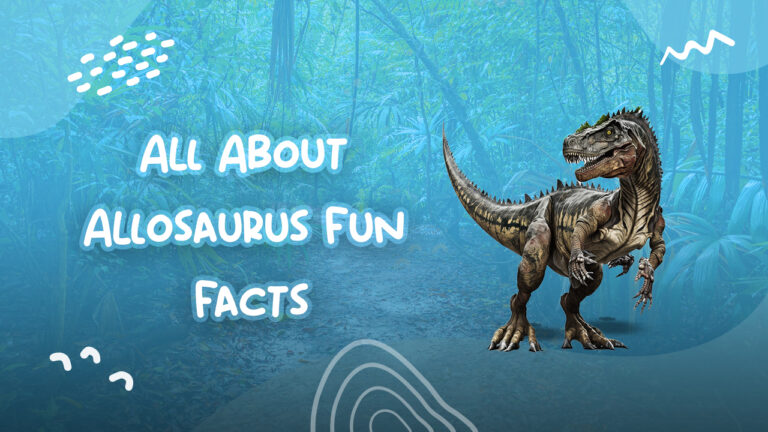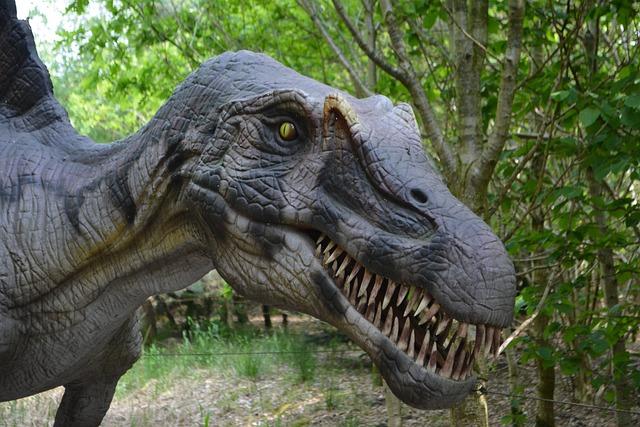All About Allosaurus Fun Facts

Allosaurus is one of the most iconic and well-known dinosaur species. One quick Allosaurus fun fact is that it was a large, carnivorous theropod dinosaur that lived during the Late Jurassic period, approximately 155 to 145 million years It was one of the most successful predators of its time, and its remains have been found in many parts of the world.
Allosaurus is one of the most iconic dinosaurs of the Jurassic period, and its impressive size and powerful jaws have made it a favorite among dinosaur enthusiasts. In this article, we will tackle the iconic Allosaurus fun facts.
Allosaurus Fun Facts–A Comprehensive Guide to its Anatomy
This section of Allosaurus Fun Facts about its anatomy tackles the skull, teeth, size, and length of Allosaurus, providing a deep dive into the physical characteristics that made this predator a formidable force in its Jurassic environment.
Allosaurus Anatomy
Allosaurus was a bipedal dinosaur. It had a large head with powerful jaws and sharp teeth, and its body was covered in thick scales.
Allosaurus Skull
One Allosaurus fun fact is that Allosaurus had a large skull with a wide, deep snout and large, sharp teeth. Its teeth were curved and serrated and were used to tear and shred its prey. Its eyes were large and its vision was good. Its neck was long and flexible, allowing it to move its head in all directions.
Allosaurus Size and Length
Allosaurus had a large body with a bulky torso and powerful hind legs. Its arms were relatively short and its tail was long and stiff. Its feet were large and had three toes, each with a large claw.
Allosaurus was a large predator, measuring up to 12 meters (39 feet) in length and weighing up to 4 tons. It had a large head, a long neck, and powerful hind legs. Its arms were relatively short and its tail was long and stiff.
Allosaurus Fun Facts–A Comprehensive Guide to its Diet
Allosaurus Diet
Allosaurus was a carnivore and its diet consisted mainly of large animals such as other dinosaurs, mammals, and fish. It was an opportunistic hunter and scavenger and would eat whatever it could find. Its teeth were well-suited for tearing and shredding flesh, and its powerful jaws could crush bone.
Allosaurus Fun Facts–A Comprehensive Guide to its Behavior
Exploring the behavior of Allosaurus offers fascinating insights into its daily life and survival strategies. These Allosaurus Fun Facts shed light on how this dominant predator interacted with its environment, hunted its prey, and possibly lived in groups during the Jurassic period.
Allosaurus Hunting Behavior
Another Allosaurus fun facts is about its behavior, how it act as a hunter and a predator of the prehistorix era.
Solitary Hunter
Allosaurus was a solitary hunter, meaning it did not hunt in packs like some other carnivorous dinosaurs. It was an ambush predator, meaning it would wait in hiding and then attack its prey when it was least expecting it. Allosaurus was an opportunistic hunter, meaning they would take advantage of any opportunity to feed, even if it meant scavenging from other predators.
Territorial Animal
Here’s an Allosaurus fun fact, Allosaurus was also a territorial animal, meaning it would defend its territory from other predators. It was also a social animal, meaning it would interact with other Allosaurus in its area. Allosaurus would often form small groups, and they would hunt together and share food. They would also communicate with each other through vocalizations and body language.
Apex Predator
Allosaurus was an apex predator, meaning it was at the top of the food chain. It was a powerful and dangerous animal, and it was feared by other animals in its environment. Allosaurus was an important part of the Late Jurassic ecosystem, and its presence helped to keep the balance of nature in check.
Quick FAQs and Allosaurus Fun Facts
Here are some fast Allosaurus fun facts:
Did Allosaurus use its head like an axe?
The answer is yes, Allosaurus did use its head like an axe, an intriguing detail among Allosaurus fun facts. Evidence from fossilized Allosaurus skulls and jaws suggests that the dinosaur had a powerful bite, but its teeth were not as strong as those of other large predators like Tyrannosaurus rex.
This suggests that Allosaurus used a different attack style than its contemporaries, a unique strategy that adds to the fascinating Allosaurus fun facts.
Attack Style and Method
Here is an Allosaurus fun Fact, It is believed that Allosaurus used a unique attack style, known as the slash and tear method, to take down its prey. Rather than relying on a powerful muscle-driven bite, it used its head as a weapon, driving its jaws into its prey like an axe and letting its serrated teeth slash through, causing devastating wounds and ultimately leading to its victims’ demise.
It is thought that this method of attack was incredibly effective, allowing Allosaurus to take down even the largest of prey with relative ease. Furthermore, the slash-and-tear method allowed Allosaurus to feed on its prey without having to expend too much energy, making it an efficient hunter. Is it an amazing Allosaurus fun fact, right?
What was the Allosaurus killing method?
One study has also shown that Allosaurus likely would have similarly de-fleshed its prey to a falcon. It would have braced its kill with its claws and pulled straight back on each bite with its powerful neck. This would have allowed it to strip the flesh from its prey quickly and efficiently. Amazing Aloosaurus fun fact, right?
The Allosaurus was also a fast runner, which would have allowed it to chase down its prey and catch it before it could escape. This would have been especially useful when hunting smaller prey, such as lizards and small mammals.
Why was Allosaurus so successful?
Another Allosaurus fun fact, Allosaurus was one of the most successful predators of its time due to its size, agility, and adaptability. Allosaurus could grow up to 30 feet long, making them one of the largest land predators of their time. This size gave them an advantage when hunting, as they could take down larger prey than their smaller competitors. Allosaurus was also agile and quick, allowing them to chase down their prey with ease.
Amazing Allosaurus Fun Fact For its Type of Diet
Allosaurus was also a carnivore, meaning it primarily ate meat. This gave them an advantage over other predators that relied on scavenging or plant-based diets. Allosaurus had sharp teeth and claws that allowed them to tear into their prey and consume it quickly. This allowed them to hunt more efficiently and get the most out of their meals.
Finally, Allosaurus was highly adaptable and could be found across North America, Europe, and Asia. This allowed them to take advantage of different environments and prey sources, giving them an edge over other predators that were limited to one region. Allosaurus was also able to survive in a variety of climates, allowing them to thrive in different habitats.
Fast Allosaurus Fun Facts Matches
Allosaurus vs. Carnotaurus
Allosaurus was much larger than Carnotaurus, reaching lengths of up to 30 feet compared to Carnotaurus’s maximum length of 23 feet. Allosaurus also had a much more powerful bite, with a bite force estimated to be up to three times stronger than Carnotaurus’s.
Allosaurus vs. Ceratosaurus
Allosaurus was much larger than Ceratosaurus, reaching lengths of up to 30 feet compared to Ceratosaurus’s maximum length of 20 feet. Allosaurus also had a much more powerful bite, with a bite force estimated to be up to four times stronger than Ceratosaurus’s.
Allosaurus vs. Mapusaurus
Allosaurus was much larger than Mapusaurus, reaching lengths of up to 30 feet compared to Mapusaurus’s maximum length of 25 feet. Allosaurus also had a much more powerful bite, with a bite force estimated to be up to five times stronger than Mapusaurus’s.
Allosaurus vs. Tyrannosaurus
Allosaurus was much smaller than Tyrannosaurus, reaching lengths of up to 30 feet compared to Tyrannosaurus’s maximum length of 40 feet. Allosaurus also had a much weaker bite, with a bite force estimated to be up to one-third as strong as Tyrannosaurus.
Overall, Allosaurus was a formidable predator of the Jurassic period, but it was no match for the larger and more powerful Tyrannosaurus.
Allosaurus Fun Facts–Significance of Allosaurus
Another Allosaurus Fun Fact, the Allosaurus is an iconic dinosaur that has been studied for centuries. Allosaurus was an important part of the Late Jurassic ecosystem. Allosaurus was also an important part of the fossil record, providing scientists with valuable information about the Late Jurassic period. Its iconic status has made it one of the most recognizable dinosaurs in the world.
Summary
Allosaurus was a formidable predator and one of the most successful predators of its time, a highlight among Allosaurus fun facts. Its size, strength, and agility made it a formidable opponent, underscoring its reputation in Allosaurus fun facts.
Its large size and powerful jaws allowed it to take down large prey, while its sharp teeth and powerful jaws enabled it to tear and shred its prey efficiently. Its long neck and flexible head allowed it to move its head in all directions, giving it an advantage when hunting. It was enjoyable learning the Allosaurus fun facts, enriching our understanding of this prehistoric giant.
Discover more about your favorite dinosaur at Dinosaurzus!

Top posts
related articles
Discover the Awesome Top 10 Longest Dinosaur Names
Dinosaurs, the ancient giants that once roamed the Earth, continue to capture our imagination. While
Discover the Amazing Dinosaur with 500 Teeth
Dinosaurs have always fascinated us with their colossal size, unique features, and intriguing mysteries. One
The Acheroraptor: An Insight into a Tiny but Fierce Dinosaur
The dinosaur world is undoubtedly fascinating, and the relative discovery of the acheroraptor is no
Epic Tale: Cryolophosaurus, Rise of the King
Cryolophosaurus, also known as the ‘Antarctic King’, was a fierce and fascinating dinosaur that existed
Torosaurus: The Horned Dinosaur with a Mysterious Identity
Dinosaurs don’t exist anymore, but their fossils still fascinate us. Paleontologists scour the earth to
Exploring the Wondrous World of Corythosaurus
The world of dinosaurs never stops fantastic us. From the huge T-rex to the tiny


